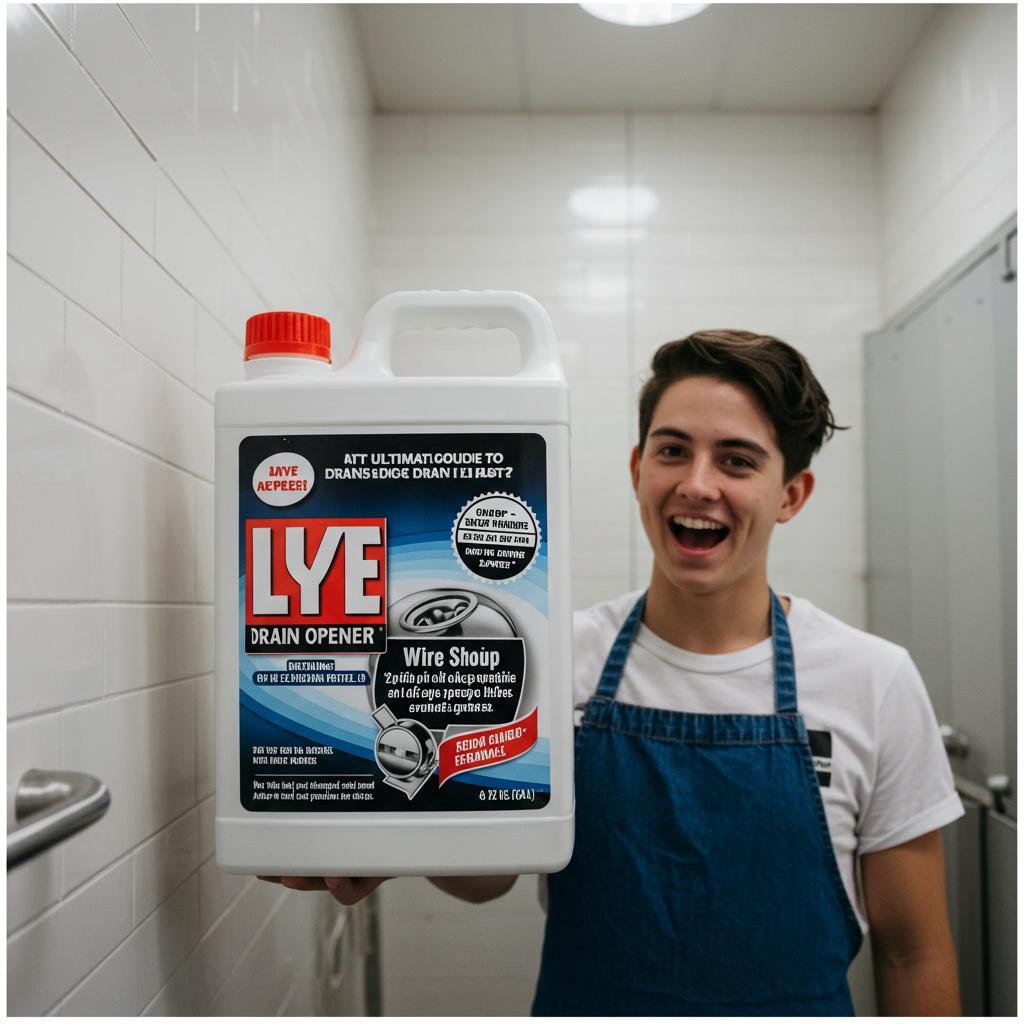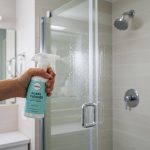[Check Latest Arrivals lye drain opener on Amazon.]
# Lye Drain Opener: The Ultimate Guide to Unclogging Drains Fast
Is your drain clogged again? Are you tired of slow-draining sinks and showers? You’re not alone! Clogged drains are a common household problem, and one of the most effective solutions for stubborn blockages is a lye drain opener. This guide will walk you through everything you need to know about using lye drain opener to quickly and effectively clear your drains. From understanding what lye is to step-by-step instructions, safety precautions, and even alternatives, we’ve got you covered. Get ready to say goodbye to those frustrating clogs for good!
[Explore Top Rated lye drain opener on Amazon.]
## What is Lye and How Does it Unclog Drains?
Lye, also known as sodium hydroxide (NaOH) or caustic soda, is a highly alkaline chemical compound. Its powerful properties make it incredibly effective at dissolving organic materials like hair, grease, soap scum, and food particles – the usual culprits behind clogged drains.
Here’s how lye works:
* **Saponification:** Lye reacts with fats and oils in a process called saponification, turning them into soap-like substances that are easily washed away by water.
* **Protein Breakdown:** It breaks down proteins like hair and food scraps, effectively dissolving them and clearing the blockage.
* **Heat Generation:** The chemical reaction between lye and water generates heat, which further helps to melt and dissolve stubborn clogs.
However, it’s crucial to remember that lye is a corrosive substance and should be handled with extreme care. We’ll cover safety precautions in detail later in this guide.
[Explore Top Rated lye drain opener on Amazon.]
## Step-by-Step Guide to Unclogging Drains With Lye Drain Opener
Before you start, make sure you have the following items:
* Lye drain opener (sodium hydroxide)
* Protective gloves (chemical-resistant)
* Safety goggles
* A long-sleeved shirt and pants
* A plastic or stainless steel container (not aluminum)
* A long stirring utensil (plastic or stainless steel)
* Cold water
**Important Safety Note:** Always work in a well-ventilated area. Never mix lye with other drain cleaners, especially those containing acid (like sulfuric acid), bleach, or ammonia, as this can cause dangerous and potentially explosive reactions.
### Step 1: Preparation is Key
Protect yourself! Put on your safety goggles, gloves, and protective clothing. This is non-negotiable – lye can cause severe burns to your skin and eyes. Open a window or turn on a ventilation fan to ensure good airflow.
### Step 2: Mixing the Lye Solution
**Carefully** measure out the lye drain opener according to the product instructions. A general guideline is about 1 cup of lye per application, but always refer to the manufacturer’s recommendations. Pour the lye slowly into the plastic or stainless steel container.
Gradually add cold water to the container, using approximately 2-3 cups of water per cup of lye. Stir the mixture slowly and carefully with your stirring utensil. The mixture will heat up rapidly, so be prepared for steam.
### Step 3: Applying the Lye Solution to the Drain
Slowly and carefully pour the lye solution down the clogged drain. Avoid splashing, as the solution is corrosive.
### Step 4: Let it Work its Magic
Allow the solution to sit in the drain for at least 30 minutes. For stubborn clogs, you can let it sit for several hours, or even overnight.
### Step 5: Flush the Drain with Hot Water
After the waiting period, carefully flush the drain with plenty of hot water. Run the water for several minutes to ensure that all the lye and dissolved debris are completely flushed away.
### Step 6: Repeat if Necessary
If the drain is still clogged after the first attempt, repeat the process. Sometimes, a particularly stubborn clog requires a second dose of lye drain opener.
**Important:** If the drain remains clogged after two attempts, it’s time to call a professional plumber. There may be a more serious issue that requires specialized tools and expertise.
[Explore Top Rated lye drain opener on Amazon.]
## Tools for the Job: Recommended Products
While the lye is the star of the show, having the right tools can make the process safer and more effective. Here are a couple of recommended products you might find helpful:
* **Green Gobbler Drain Opening Pacs:** These pre-measured pacs make using lye drain cleaner easier and safer. Their key feature is pre-measured dosages, making it much simpler to avoid spills and use the correct amount. *Why we like it:* Less chance of splashing or using too much. The pre-measured packets are also easier to store.
* **Chemical Resistant Gloves, MAPA Jersette 301:** These gloves are essential for protecting your hands from the corrosive effects of lye. *Why we like it:* The long cuffs provide added protection, and the textured surface ensures a good grip, even when wet.
[Explore Top Rated lye drain opener on Amazon.]
## Pro-Tips and FAQ’s About Lye Drain Opener
Here are some additional tips and frequently asked questions to help you get the most out of your lye drain opener experience:
* **Prevention is key:** To prevent future clogs, flush your drains with hot water regularly, and avoid pouring grease, oil, or food scraps down the drain.
* **Don’t mix with other chemicals:** As mentioned earlier, never mix lye with other drain cleaners or chemicals, especially acids, bleach, or ammonia. This can create dangerous fumes and even explosions.
* **Ventilation is crucial:** Always work in a well-ventilated area to avoid inhaling harmful fumes.
* **Store lye safely:** Keep lye drain opener in a tightly sealed container, out of reach of children and pets.
**FAQ:**
* **Is lye drain opener safe for all types of pipes?** Lye is generally safe for metal and PVC pipes. However, it’s not recommended for use in older plumbing systems with galvanized steel pipes, as it can corrode them over time.
* **Can I use lye drain opener in my toilet?** While lye *can* be used in toilets, it’s generally not recommended. Toilets often have more complex plumbing systems, and using too much lye can damage the wax ring seal.
* **How often can I use lye drain opener?** It’s best to use lye drain opener sparingly, as overuse can damage your pipes. Try to limit its use to only when necessary, and consider using alternative drain cleaning methods in between.
* **What if I spill lye on my skin?** Immediately rinse the affected area with plenty of cold water for at least 15 minutes. Remove any contaminated clothing. Seek medical attention if you experience any burns or irritation.
* **What if I get lye in my eyes?** Immediately flush your eyes with plenty of cold water for at least 15 minutes. Seek immediate medical attention.
[Explore Top Rated lye drain opener on Amazon.]
## Alternatives to Lye Drain Opener
While lye drain opener is a powerful and effective solution for clogged drains, it’s not the only option. If you’re concerned about the safety or environmental impact of using lye, here are some alternatives:
* **Boiling Water:** For minor clogs caused by grease or soap scum, pouring boiling water down the drain can often do the trick.
* **Baking Soda and Vinegar:** This classic combination creates a fizzy reaction that can help break down mild clogs. Pour 1 cup of baking soda down the drain, followed by 1 cup of vinegar. Let it fizz for 30 minutes, then flush with hot water.
* **Plunger:** A good old-fashioned plunger can be surprisingly effective at dislodging clogs.
* **Drain Snake/Auger:** A drain snake or auger is a flexible tool that can be inserted into the drain to break up or pull out clogs.
* **Enzymatic Drain Cleaners:** These cleaners use enzymes to break down organic matter and are a gentler alternative to chemical drain openers.
[Explore Top Rated lye drain opener on Amazon.]
## Encouraging Conclusion
Congratulations! You’ve now got the knowledge and tools to tackle those stubborn drain clogs with confidence using lye drain opener. Remember to prioritize safety by wearing protective gear and following the instructions carefully. While lye can be a powerful solution, it’s essential to use it responsibly. If you follow these steps and use caution, you can restore your drains to their former glory and say goodbye to those frustrating slow drains. And if all else fails, don’t hesitate to call a professional plumber – they’re always there to help when you need them!
[Shop Budget-Friendly lye drain opener on Amazon.]




![Purell Soap Dispenser: Which is Best for Your Home or Office? [2026 Guide]](https://www.besthomecleaningreviews.com/wp-content/uploads/2025/10/514-purell-soap-dispenser-which-is-best-for-your-home-or-office-2026-guide-150x150.png)





